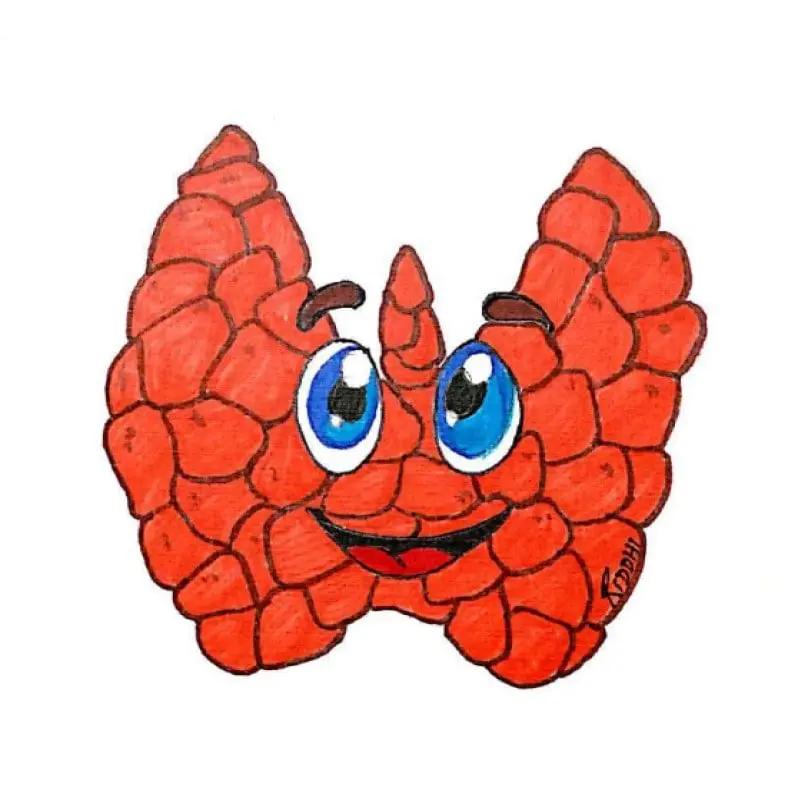
This post is about endocrinology of thyroid gland, here we will learn about Thyroid Hormones, their Chemistry, Synthesis, where they are Stored, their Transport and Functions. So, let’s start from introduction.
Table of Contents
ToggleINTRODUCTION TO THYROID HORMONES
- Thyroid is an endocrine gland (ductless gland that secretes their products directly in the bloodstream).
- Situated at the root of the neck on either side of the trachea.
- It has two lobes, which are connected in the middle by an isthmus.
- It weighs about 20 to 40 g in adults.
- Thyroid is larger in females than in males.
- Its function increases slightly during pregnancy and lactation.
- But decreases during menopause.
HISTOLOGY OF THYROID GLAND
- Thyroid gland is composed of large number of closed follicles.
- These follicles are lined with cuboidal epithelial cells, which are called the follicular cells.
- Follicular cells secrete tetraiodothyronine (T4 or thyroxine) & Tri-Iodothyronine (T3).
- In between the follicles, the parafollicular cells are present. These cells secrete calcitonin hormone.
HORMONES OF THYROID GLAND
THREE HORMONES are there
- Tetraiodothyronine or T4 (thyroxine)
- Tri-iodothyronine or T3
- Calcitonin.
T4 is otherwise known as thyroxine and it forms about 90% of the total secretion, whereas T3 is only 9% to 10%.
THYROID HORMONE SYNTHESIS
Synthesis of thyroid hormones takes place in follicular cavity.
Iodine and Tyrosine (L Tyrosine) are essential for formation of thyroid hormones.
STAGES : SIX
1) Thyroglobulin Synthesis
- Endoplasmic reticulum and Golgi apparatus in follicular cells of thyroid gland synthesizes thyroglobulin.
- Thyroglobulin molecule is a glycoprotein, which is stored in follicle.
2) Iodide Trapping
- Iodide is actively transported from blood into follicular cell against electrochemical gradient.
3) Oxidation of Iodide
- Iodide must be oxidized and transported from follicular cells into follicular cavity.
4) Transport of Iodine into Follicular Cavity
- From follicular cells, iodine is transported into follicular cavity by an Iodide-chloride pump called pendrin.
5) Iodination of Tyrosine
- Combination of iodine with tyrosine is known as iodination. It takes place in thyroglobulin.
- Tyrosine is iodized first into monoiodotyrosine (MIT) and later into diiodotyrosine (DIT).
6) Coupling Reactions
- Tyrosine + I = Monoiodotyrosine (MIT)
- MIT + I = Diiodotyrosine (DIT)
- DIT + MIT = Tri-iodothyronine (T3)
- DIT + DIT = Tetraiodothyronine or Thyroxine (T4)
STORAGE OF THYROID HORMONES
After synthesis, thyroid hormones remain in the form of vesicles within thyroglobulin and are stored for long period.
THYROID HORMONE (THYROXINE) FUNCTIONS
1) Increases Metabolic activities in most of body tissues.
2) Increases BMR by increasing oxygen consumption of tissues.
3) Increases Synthesis of Proteins in cells by increasing,
- Translation of RNA
- Transcription of DNA to RNA
- Activity of Mitochondria
- Activity of Cellular Enzymes
4) Stimulates Metabolism of Carbohydrate by increasing,
- Glucose uptake by cells.
- Breakdown of Glycogen into glucose.
- Gluconeogenesis.
5) Decreases Fat storage – Fat is converted into free fatty acid and transported by blood.
6) Increases Heat production in body, by accelerating various cellular metabolic process and increasing BMR.
7) Important to promote Growth & Development of brain during fetal life and for first few years of life.
8) Essential for maintaining the Body weight.
9) Accelerates erythropoietic activity & Increases Blood volume.
10) Increases Heart rate and force of contraction. So, Cardiac output and blood pressure increases.
11) Increases Rate and Force of Respiration indirectly.
12) Increases Appetite and food intake.
- It also increases secretions & movements of GI tract.
13) Essential for development and maintenance of normal functioning of Central Nervous System(CNS).
14) Is stimulating factor for CNS.
- So a person is having anxiety complexes, excess worries in hyperthyroidism.
- Hyposecretion of thyroxine leads to lethargy and excess sleep.
15) Essential for normal activity of Skeletal muscles.
- Hypersecretion of thyroxine causes weakness of the muscles and muscular tremor.
16) Normal thyroxine level is necessary to maintain normal Sleep pattern.
- Hypersecretion reduces sleep
- Hyposecretion causes increase in sleep.
17) Normal thyroxine level is essential for normal Sexual Function.
- In women, Hypothyroidism causes Menorrhagia.
- In some women, it causes Amenorrhea.











Good
Thank you
So much Informative
Clear and Precise